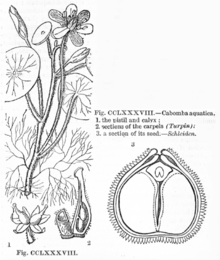Cabomba
| Cabomba | |
|---|---|

| |
| Cabomba aquatica (from Lindley 1853) | |
| Scientific classification | |
| Kingdom: | Plantae |
| Clade: | Tracheophytes |
| Clade: | Angiosperms |
| Order: | Nymphaeales |
| Family: | Cabombaceae |
| Genus: | Cabomba Aubl. |
| Type species | |
| Cabomba aquatica Aublet[1] | |
| Species | |
|
See text | |
| Synonyms[2] | |
| |
Cabomba is an aquatic plant genus, one of two belonging to the family Cabombaceae. It has divided submerged leaves in the shape of a fan (hence the vernacular name fanwort) and is much favoured by aquarists as an ornamental and oxygenating plant for fish tanks. One species, Cabomba caroliniana, is a nationally declared weed in Australia, where it has choked up waterways after escaping from aquaria.

Taxonomy[edit]
Species[edit]
The genus Cabomba Aubl. consists of six species:[2]
- Cabomba aquatica Aubl. (fanwort)
- Cabomba caroliniana A. Gray (green cabomba)
- Cabomba furcata Schult. & Schult.f. (red cabomba)
- Cabomba haynesii Wiersema
- Cabomba palaeformis Fassett
- Cabomba schwartzii Rataj
Flowers and reproduction[edit]

The perianth of Cabomba is either trimerous (having members in each whorl in groups of three) or dimerous (in groups of two) with white, oval-shaped petals, and is usually about 2.0 cm (0.79 in) across when fully developed. The petals are unlike the sepals in that the former have two yellow ear-shaped nectaries at the base. Petals may also have purplish edges. Flowers are protogynous, having primarily female sexual structures on the first day of appearance and then switching to male on the second and subsequent days. Flowers emerge and are designed to be pollinated above the waterline. Principal pollinators are flies and other small flying insects.[3]
Cabomba as an aquarium plant[edit]
Cabomba is frequently planted in aquaria, as an attractive-leaved water plant that is fast-growing (up to 1 in (25 mm) per day). Green cabomba (C. caroliniana) is the most common, and the easiest aquarium subject. By contrast, red cabomba (C. furcata) is considered to be one of the hardest plants to care for in the aquarium.[citation needed]
Invasive species[edit]
Use in the aquarium trade has led to some species being introduced to other parts of the world, such as Australia, where Cabomba caroliniana it is a nationally declared weed.[4] Having arrived in 1967, it spread rapidly in waterways and out-competed native plants, threatening water supplies, especially along the eastern side of the continent.[5] In Australia, the cabomba weevil (Hydrotimetes natans) is introduced to waterways as a means of biological control of Cabomba caroliniana.[6][5] They consume the plant's tips and inflict significant harm when present in large quantities. Larvae burrow within the stems and result in substantial damage to the main stem due to tissue necrosis.[7]
References[edit]
- ^ Cabomba | International Plant Names Index. (n.d.). Retrieved August 13, 2023, from https://www.ipni.org/n/328528-2
- ^ a b "Cabomba Aubl". Plants of the World Online. Royal Botanic Gardens, Kew. Retrieved 12 January 2024.
- ^ Klaus Kubitzki; Jens G. Rohwer; Volker Bittrich (28 July 1993). Flowering Plants · Dicotyledons: Magnoliid, Hamamelid and Caryophyllid Families. Springer Science & Business Media. p. 159. ISBN 978-3-540-55509-4.
- ^ "Cabomba (Cabomba caroliniana)". NSW WeedWise. 24 January 2020. Retrieved 13 July 2023.
- ^ a b Nichols, Jennifer (10 July 2023). "Cabomba weevil unleashed on weed-infesting Australian waterways". ABC News (Australia). Retrieved 12 July 2023.
- ^ Australian Government Department of Agriculture, Fisheries and Forestry. (2023, May 9). Hydrotimetes natans for the biological control of Cabomba caroliniana. Retrieved October 2, 2023, from https://www.agriculture.gov.au/biosecurity-trade/policy/risk-analysis/biological-control-agents/risk-analyses/completed-risk-analyses/ra-release-hydrotimetes-natans
- ^ Kumaran, N., Vance, T. J., Comben, D., Dell, Q., Oleiro, M. I., Goñalons, C. M., ... & Raghu, S. (2022). "Hydrotimetes natans as a suitable biological control agent for the invasive weed Cabomba caroliniana." Biological Control, 169, 104894.
- Ørgaard, M. (1991). The genus Cabomba (Cabombaceae) - a taxonomic study. Nordic Journal of Botany 11: 179-203
- Day, C., Petroechevsky, A., Pellow, B., Bevan, J., O’Dwyer, T., StLawrence, A. and Smith, G. (2014). Managing a priority outlier infestation of Cabomba caroliniana in a natural wetland in the Blue Mountains, NSW, Australia – could this be eradication? Draft Paper to 19th Australasian Weeds Conference, Hobart, Australia.
- Fassett, N.C. 1953. A monograph of Cabomba. Castanea
External links[edit]
![]() Media related to Cabomba at Wikimedia Commons
Media related to Cabomba at Wikimedia Commons
